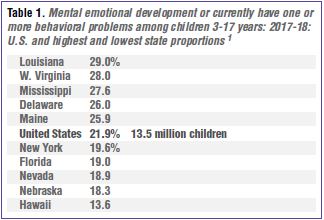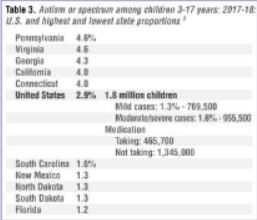AMERICAN ACADEMY OF DEVELOPMENTAL MEDICINE & DENTISTRY
Increasing numbers of residents with disabilities (Even for very young children)
BY H. BARRY WALDMAN, DDS, MPH, PHD, RICK RADER, MD, DHL (HON) AND STEVEN P. PERLMAN, DDS, MSCD, DHL (HON)
A series of previous writings in Exceptional Parent Magazine emphasized the inadequate reports by the U.S. Census Bureau in its annual American Community Survey demographic findings that an estimated 155,000 children less than five years of age among the civilian noninstitutionalized population had one or more severe disabilities. The reality is that the Census Bureau only includes children with disabilities in the less than five-year count who have hearing and vision difficulties. For all other age groups, six disability categories (hearing, vision, cognitive, ambulatory, self-care and independent living difficulties) are collected and described. 1,2
A report from the National Center for Health Statistics on "The Prevalence of Developmental Disabilities Among U.S. Children Aged 3-17 Years" (emphasis added) listed the current status which indicated increases between 2009 and 2017. 3 Recognizing the difficulties associated with determining the type and degree of disability for very young children, the previous writing in EP Magazine suggested a third category for youngsters less than five years of age with disabilities: "1) hearing limitations, 2) sight limitations and 3) other disabilities with the Type and severity to be determined at an older age." 2
The 2020 report by the Data Resource Center for Child and Adolescent Health for the 2017-2018 National Survey of Children's Health takes on this controversy by including at the state and national levels information for the: 1) mental and emotional development, 2) attention deficit disorder (ADD)/attention deficit hyperactive disorder (ADHD) and 3) autism or spectrum among children 3-17 years.
In addition, the study report provides an extended series of child-related health information, including: 1) the children's physical, oral health status, 2) health insurance availability, 3) general health care access and 4) the quality of care. 4
Unfortunately, while the study includes information in the 3-5 years of age range, it does not segregate the data from the overall general 3-17 years information. This separate arrangement would demonstrate the need for the Census Bureau to consider increasing the range of disabilities for children in the under-five age category.
SPECIFICALLY
• Mental emotional development: Across the nation, 13.5 million children (21.9%) between ages 3-17 years, have mental or emotional development difficulties or currently have one or more behavioral problems; ranging from 13.6 percent in Hawaii to more than double the proportion at 29.0 percent in Louisiana (see Table 1).

AMERICAN ACADEMY OF DEVELOPMENTAL MEDICINE AND DENTISTRY
The American Academy of Developmental Medicine and Dentistry (AADMD) was organized in 2002 to provide a forum for healthcare professionals who provide clinical care to people with neurodevelopmental disorders and intellectual disabilities (ND/ID). The mission of the organization is to improve the quality and assure the parity of healthcare for individuals with neurodevelopmental disorders and intellectual disabilities throughout the lifespan.

GETTING THE DRIFT: Nationally, 3.1 million children have moderate to severe cases of ADD/ADHD ranging from 5.3 percent in New York State to almost triple the proportion at 14.9 percent in Louisiana.
• Attention Deficit Disorder/Attention Deficit Hyperactive Disorder: Regarding the nation, 5.3 million children (8.7%) between 3-17 years, have ADD/ADHD ranging from 5.3 percent in New York State to almost triple the proportion at 14.9 percent in Louisiana. Nationally, 3.1 million children have moderate to severe cases, 3.2 million children sometimes or never have adequate health insurance, 3.3 million children take medication and 2.4 million children receive behavioral treatment (see Table 2).
• Autism or spectrum: Across the nation 1.8 million children (2.9%) between 3-17 years have autism or the spectrum ranging from 1.2 percent in Florida to almost four times the proportion at 4.6 percent in Pennsylvania and Virginia. Nationally, 955,500 have moderate/severe cases and 465,700 are taking medication (see Table 3).
QUESTION
Why are the low to high ranges of the proportion of children ages 3-17 years in the U.S. states for the three disability categories, respectively, more than double, almost triple and almost quadruple? (see Tables 1-3) Yes, the actual number of children with disabilities, to a great extent, reflect the marked differences in the total state populations. But why are there such differences in the proportions between the state levels?
SOME RESPONSES
In addition to differences in state (and federal government-supported programs, e.g. Medicaid and Children Health Insurance Program [CHIP]), variations in demographics and economics, as well as social and health factors, explain much of the marked proportional differences between states.
"Poverty and disability are intricately related… (decades) after the passage of the Americans with Disabilities Act (ADA), adults with disabilities are twice as likely to live in poverty as those without a disability… (In addition, there are) important differences in the poverty rate among demographic groups who face additional economic challenges — women, members of minority groups, people with lower levels of education and assorted age groups." 5

One quarter of black residents (about the same rate as Native Americans) have incomes below the poverty level compared to approximately 12 percent of the national proportion and about 8 percent of non-Hispanic whites.
• Poverty rates of children in the Southern Region of the country (an area in which states generally have a greater proportion of black residents) are higher than other parts of the country.

• In both urban and rural areas, larger proportions of families with persons who have a disability live in poverty, than families with members who have no disabilities. In addition, women with disabilities are overwhelmingly more likely to live in poverty. The economic differences between those with and without disabilities grow as education levels increase.
• Among children with special healthcare needs living in poverty, a greater proportion need emotional, behavioral or developmental services.
• Almost one-in-five black residents lack health insurance. Lack of insurance compromises the health of the uninsured because disabilities and disease conditions are diagnosed at more advanced stages and these individuals tend to receive less preventive and therapeutic care. The disparity in the poverty rate between people with and without disabilities grows with age: Among those:
- • 18-30 years old, the poverty rate is 21 percent for those without disabilities and 32 percent for those with disabilities.
- • 30-45 years of age, 12 percent without disabilities live in poverty, as compared to 33 percent with disabilities.
- • 45-64 years old, nine percent without disabilities live in poverty, compared to 26 percent with disabilities. 5,6
FINAL QUESTION
When will all government agencies recognize the need to detail the increasing number of very young children with a range of disabilities, so that funding will be made available to provide the required care? •
ABOUT THE AUTHORS:
H. Barry Waldman, DDS, MPH, PhD is a SUNY Distinguished Teaching Professor, Department of General Dentistry, Stony Brook University, NY. E-mail: h.waldman@stonybrook.edu. Rick Rader, MD, DHL (Hon) is the Director of the Morton J. Kent Habilitation Center, Orange Groove, Chattanooga, TN; Senior VP Public Policy, American Academy of Developmental Medicine and Dentistry; Adjunct Professor, Human Development, University of Tennessee-Chattanooga. He is Exceptional Parent Magazine's Editor in Chief. Steven P. Perlman, DDS, MScD, DHL (Hon) is the Global Clinical Director and founder, Special Olympics, Special Smiles; and Clinical Professor of Pediatric Dentistry, The Boston University Goldman School of Dental Medicine.
References
- 1. Waldman HB, Perlman SP, Larsen CD. Surely there are more than about 155,000 children less than five years of age with disabilities in the U.S. EP Magazine 49:14-16, December 2018.
- 2. Waldman HB, Rader R, Perlman SP. Undercounting young children with severe disabilities: a need for change. EP Magazine 51:14-16, February 2020.
- 3. Zablotsky B, Black LI, Maenncer MJ, et al. Prevalence and trends of developmental disabilities among children in the United States 2009-2017. Available from: pediatrics.aapublications.org/con- tent/early2019/09/24/peds.2019-0811.
- 4. Data Resource Center for Child and Adolescent Health. 2017-2018 National Survey of Children's Health. Available from: childhealthdata.org/browse/survey/results?q=7096&r=1 childhealthdata.org/browse/survey Accessed June 11, 2020.
- 5. Morris M. Poverty and disability in America Matter Available from: huffpost.com/entry/poverty-and-disability-in_b_9557142 Accessed June 14, 2020,
- 6. Waldman HB, Perlman SP, Kucine, AJ. Social and health conditions of the Black/American population: the setting for children and adults with disabilities. Exceptional Parent Magazine, 38:65-67, February 2006.